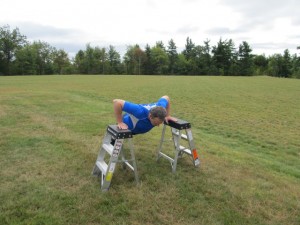BMI, also known as Body Mass Index is a simplistic notion that only a government bureaucrat could love. It divides your weight in kilograms by the square of your height in meters. If your BMI is greater than 30, you are obese. If it is greater than 25, you are overweight. If it is lower than 18.5, you are underweight.
The problem with BMI is that for those who are athletic, especially those who are quite muscular, it vastly overestimates how much body fat they have. On the other hand, for those who are sedentary and soft, it vastly underestimates how much body fat they have.
I have attached two pictures of myself taken in the past month. According to the government and insurance companies, even though you can see my ribcage, I am not merely overweight — I am OBESE. Though I’ll grant that maybe I could stand to lose five pounds for greater abdominal definition, I am most certainly not obese, and am well within a normal and healthy weight range.
And I am not alone. The simple fact is that I double-dig garden beds, split firewood, swing kettlebells and otherwise develop plenty of muscle that is much heavier than fat. And lots of other people do those things too. But all of these people are also labeled as overweight or obese. Because statistics about obesity are based upon BMI, and BMI labels guys like me who do lots of pushups as “obese” — those statistics are not meaningful. There are millions of people who skew the results.
There are many other measures that are far more reliable in determining whether or not someone is overweight.
Body fat percentage is a far better measurement. It used to be that you’d have to use calipers and skin folds or an immersion tank to measure body fat. But nowadays, you can use a simple tool that you grasp with both hands that uses bioelectrical impedance to measure your body fat. Just use it a couple of hours after your last meal and the results will be accurate. I have one that cost about $30. Just measuring your waist also works. Is your waist bigger than your hips? Then you are overweight.
This concept is not rocket science. You can usually tell if you are overweight or not with the naked eye. If not, then a simple tape measure will do the trick in most cases. As an added check, measuring body fat percentage using bioelectrical impedance is inexpensive and accurate. BMI is unnecessarily complex and based on a host of assumptions that are inaccurate for both fit and sedentary people. The problem is that public health agencies are using this erroneous measure as a way of setting public policy, and I’m sure at some point insurance companies will start using it if they haven’t already.
But you and I are neither governments nor insurance companies, so we can feel free to ignore ideas that are clearly flawed, and replace those ideas with measurements that actually work such as body fat measurement and the trusty tape measure!










